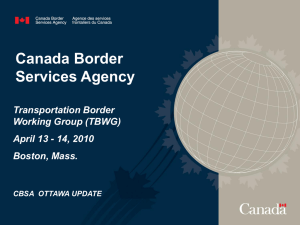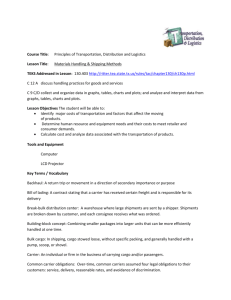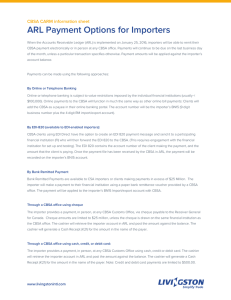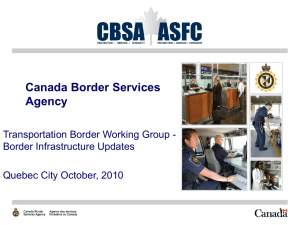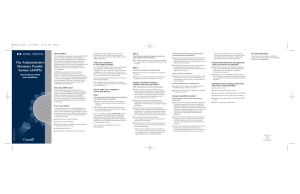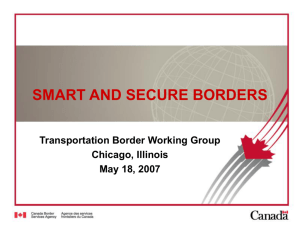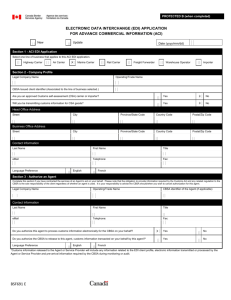How to complete an A8A - Pacific Customs Brokers
advertisement
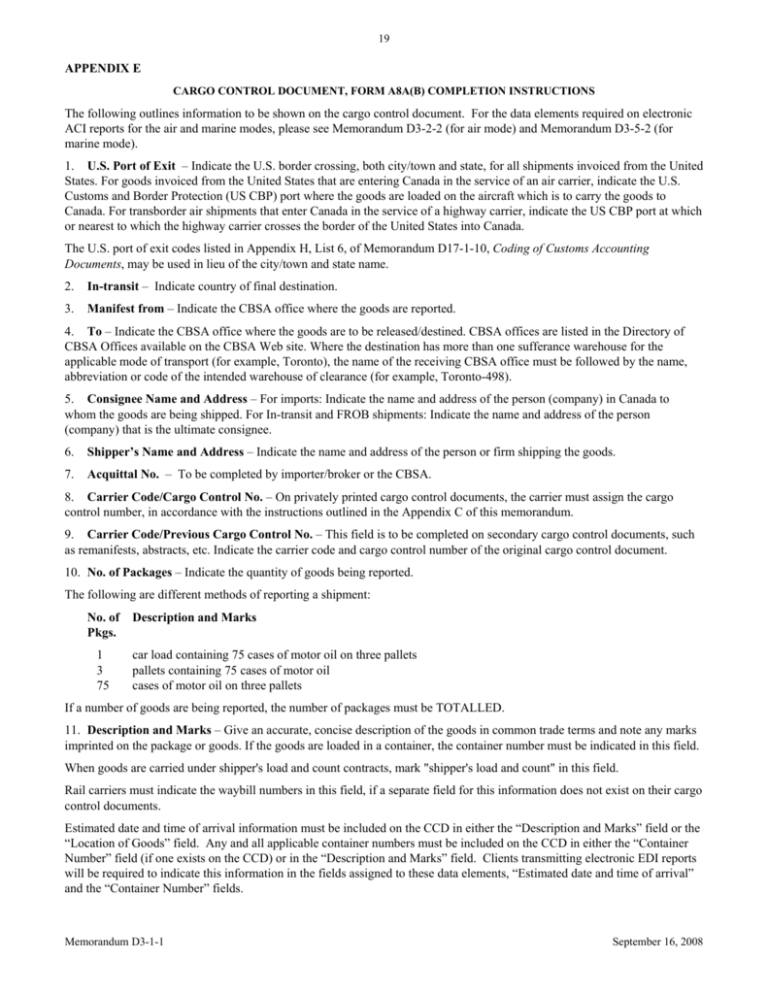
19 APPENDIX E CARGO CONTROL DOCUMENT, FORM A8A(B) COMPLETION INSTRUCTIONS The following outlines information to be shown on the cargo control document. For the data elements required on electronic ACI reports for the air and marine modes, please see Memorandum D3-2-2 (for air mode) and Memorandum D3-5-2 (for marine mode). 1. U.S. Port of Exit – Indicate the U.S. border crossing, both city/town and state, for all shipments invoiced from the United States. For goods invoiced from the United States that are entering Canada in the service of an air carrier, indicate the U.S. Customs and Border Protection (US CBP) port where the goods are loaded on the aircraft which is to carry the goods to Canada. For transborder air shipments that enter Canada in the service of a highway carrier, indicate the US CBP port at which or nearest to which the highway carrier crosses the border of the United States into Canada. The U.S. port of exit codes listed in Appendix H, List 6, of Memorandum D17-1-10, Coding of Customs Accounting Documents, may be used in lieu of the city/town and state name. 2. In-transit – Indicate country of final destination. 3. Manifest from – Indicate the CBSA office where the goods are reported. 4. To – Indicate the CBSA office where the goods are to be released/destined. CBSA offices are listed in the Directory of CBSA Offices available on the CBSA Web site. Where the destination has more than one sufferance warehouse for the applicable mode of transport (for example, Toronto), the name of the receiving CBSA office must be followed by the name, abbreviation or code of the intended warehouse of clearance (for example, Toronto-498). 5. Consignee Name and Address – For imports: Indicate the name and address of the person (company) in Canada to whom the goods are being shipped. For In-transit and FROB shipments: Indicate the name and address of the person (company) that is the ultimate consignee. 6. Shipper’s Name and Address – Indicate the name and address of the person or firm shipping the goods. 7. Acquittal No. – To be completed by importer/broker or the CBSA. 8. Carrier Code/Cargo Control No. – On privately printed cargo control documents, the carrier must assign the cargo control number, in accordance with the instructions outlined in the Appendix C of this memorandum. 9. Carrier Code/Previous Cargo Control No. – This field is to be completed on secondary cargo control documents, such as remanifests, abstracts, etc. Indicate the carrier code and cargo control number of the original cargo control document. 10. No. of Packages – Indicate the quantity of goods being reported. The following are different methods of reporting a shipment: No. of Pkgs. 1 3 75 Description and Marks car load containing 75 cases of motor oil on three pallets pallets containing 75 cases of motor oil cases of motor oil on three pallets If a number of goods are being reported, the number of packages must be TOTALLED. 11. Description and Marks – Give an accurate, concise description of the goods in common trade terms and note any marks imprinted on the package or goods. If the goods are loaded in a container, the container number must be indicated in this field. When goods are carried under shipper's load and count contracts, mark "shipper's load and count" in this field. Rail carriers must indicate the waybill numbers in this field, if a separate field for this information does not exist on their cargo control documents. Estimated date and time of arrival information must be included on the CCD in either the “Description and Marks” field or the “Location of Goods” field. Any and all applicable container numbers must be included on the CCD in either the “Container Number” field (if one exists on the CCD) or in the “Description and Marks” field. Clients transmitting electronic EDI reports will be required to indicate this information in the fields assigned to these data elements, “Estimated date and time of arrival” and the “Container Number” fields. Memorandum D3-1-1 September 16, 2008 20 12. Weight – Indicate the weight of the shipment in metric or imperial measure. The unit of measure must be noted and the weight must be TOTALLED. 13. Foreign Point of Lading – (To be completed by freight forwarders and marine carriers only) Indicate the city/town and country where the goods were loaded on board a vessel, aircraft, vehicle or rail conveyance. 14. Location of Goods – Indicate the name and address of the sufferance warehouse where goods are stored pending clearance. The name of the agent handling the load must also be shown in this field. In the case of commercial shipments, where the carrier, freight forwarder or agent are not one and the same as the sufferance warehouse, the warehouse sub-location code that has been assigned to the sufferance warehouse by the CBSA must be included. A listing of sufferance warehouse sub-location codes may be obtained by accessing the CBSA Web site, or by communicating with the CBSA Electronic Commerce Unit at the following: 1-888-957-7224 calls within Canada and the United States 1-613-946-0762 for overseas callers between 8 a.m. and 5 p.m. (E.S.T.) 1-613-946-0763 for overseas callers between 5 p.m. and 8 a.m. (E.S.T.). 15. Name of Carrier – Indicate the name of the carrier transporting the goods. 16. Vehicle Identification – Highway carriers must indicate the vehicle identification number (licence number, province or state, year and trailer number). Other modes of transportation must indicate aircraft registration numbers, rail car initials and numbers or vessel details in this field. Any field requirements specific to only one mode of transportation may be excluded by carriers of other modes of transportation. All carriers are obliged to include information on the cargo control document that will allow for the efficient tracing of CBSA documentation within their operations. An example of this form can be seen on the CBSA Web site under “Publications and Forms”. Memorandum D3-1-1 September 16, 2008

